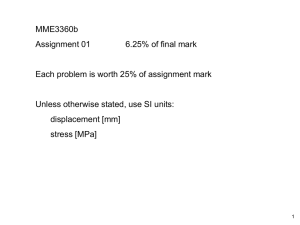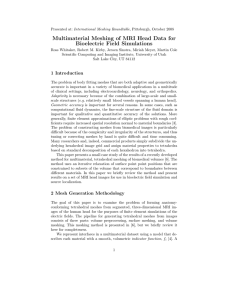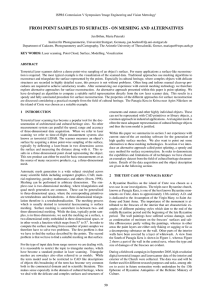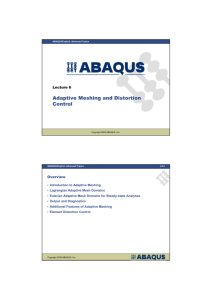Adaptive Meshing
advertisement
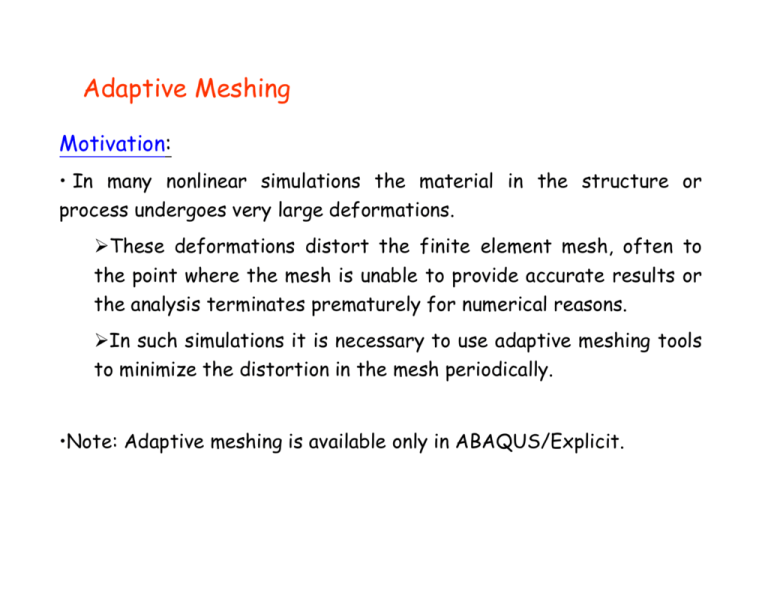
Adaptive Meshing Motivation: • In many nonlinear simulations the material in the structure or process undergoes very large deformations. ¾These deformations distort the finite element mesh, often to the point where the mesh is unable to provide accurate results or the analysis terminates prematurely for numerical reasons. ¾In such simulations it is necessary to use adaptive meshing tools to minimize the distortion in the mesh periodically. •Note: Adaptive meshing is available only in ABAQUS/Explicit. Adaptive Meshing Adaptive meshing is useful in a broad range of applications: ¾Can be used as a continuous adaptive meshing tool for transient analysis problems undergoing large deformations, such as: – Dynamic impact – Penetration – Sloshing – Forging ¾Can be used as a solution technique to model steady-state processes, such as: – Extrusion – Rolling •Can be used as a tool to analyze the transient phase in a steady-state •process. Adaptive Meshing Adaptive meshing basics – Adaptive remeshing is performed in ABAQUS/Explicit using the arbitrary Lagrangian-Eulerian (ALE) method. The primary characteristics of the adaptive meshing capability are: – The mesh is smoothed at regular intervals to reduce element distortion and to maintain good element aspect ratios. – The same mesh topology is maintained—the number of elements and nodes and their connectivity do not change. - It can be used to analyze Lagrangian (transient) problems and Eulerian (steady-state) problems. Adaptive Meshing Arbitrary Lagrangian-Eulerian (ALE) method Lagrangian Nodes move exactly with material points. description It is easy to track free surfaces and to apply boundary conditions. The mesh will become distorted with high strain gradients. Eulerian Nodes stay fixed while material flows through the mesh. description It is more difficult to track free surfaces. No mesh distortion because mesh is fixed. The implementation current of Eulerian description is limited. ALE Mesh motion is constrained to the material motion only where necessary (at free boundaries), but otherwise material motion and mesh motion are independent. Adaptive Meshing Arbitrary Lagrangian-Eulerian (ALE) method ALE Mesh motion is constrained to the material motion only where necessary (at free boundaries), but otherwise material motion and mesh motion are independent. • Motion of mesh and material with various methods Adaptive Meshing ALE simulation of an axisymmetric forging problem Adaptive Meshing By using the adaptive meshing capability, a high-quality mesh can be maintained throughout the entire forging process. Nodes along the free boundary move with the material in the direction normal to the material’s surface. They are allowed to adapt (adjust their position) tangent to the free surface. Interior nodes adaptively adjust in all directions ALE simulation: deformed mesh at 100% of die travel Adaptive Meshing – In a transient (Lagrangiantype) problem, such as this forging simulation, minimal additional input is required to invoke the adaptive meshing capability. – Adaptive meshing is available for all first-order, reduced-integration continuum elements. • Other element types may exist in the model. Adaptive Meshing Adaptive meshing consists of two fundamental tasks: • creating a new mesh, and • remapping solution variables from the old mesh to the new mesh with a process called advection. Meshing A new mesh: • is created at a specified frequency for each adaptive domain; • is found by sweeping iteratively over the adaptive mesh domain and moving nodes to smooth the mesh; and • can retain the initial gradation of the original mesh. Adaptive Meshing Remapping The methods used for advecting solution variables to the new mesh: • are consistent, monotonic, and (by default) accurate to the second order; and • conserve mass, momentum, and energy. Adaptive Meshing Mesh smoothing methods Volume smoothing Volume smoothing relocates a node by computing a volume weighted average of the element centers in the elements surrounding the node. Laplacian smoothing Laplacian smoothing relocates a node by calculating the average of the positions of each of the adjacent nodes connected by an element edge to the node in question. Equipotential smoothing Equipotential smoothing is a higher-order method that relocates a node by calculating a higher-order, weighted average of the positions of the node's eight nearest neighbor nodes in two dimensions. 1.3.14 Axisymmetric extrusion: transient and steady-state Abaqus Example Problems Manual 1.3.14 Axisymmetric extrusion: transient and steady-state





